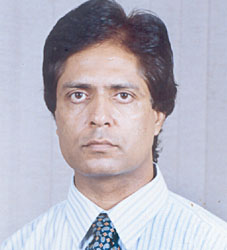Peepli Dead: True Story of Cyber Zombies in India
By Rakesh Raman
The recent Bollywood movie, Peepli Live, which earned rave reviews, was a work of fiction – though it tried to portray the actual ugly face of India with a sarcastic tenor.
However, our new story Peepli Dead is as real as the moon in the sky. And it depicts the sorry state of Indian governance that is hell-bent to kill e-governance in the country.
The only fictional part in this story is the name of the anchorman Ram Rakha – a changed name to protect his identity.
Rest everything is real. And you’ll realize that our man faces more hardships than Natha of Peepli Live.
Here it goes:
Ram Rakha is an educated young man who lives in India’s capital New Delhi. As he has been working in the field of information technology (IT), he understands that technology can be extremely helpful to serve the masses in his country of one billion people.
He also knows that technology-led governance can empower people to easily interact with the government in a fearless manner.
But the experience…
With this confidence in the power of technology, recently Ram decided to leverage the e-governance systems in India to seek justice from the government for a public interest case that points to corruption in government-managed outfits.
Since the case was related to a co-operative group housing society, Ram approached the concerned department Registrar Co-operative Societies (RCS) of Delhi government by sending an e-mail communication through proper channel in the Month of May this year (2010).
There was no response from the RCS office – not even an acknowledgement. Obviously, Ram was surprised. He decided to complain to the Delhi Chief Minister’s office again through the available e-governance interface.
Again, no response. Ram’s wait kept stretching from days to weeks to months. During this period, Ram sent multiple e-mails on the same case to RCS office as well as the Delhi Chief Minister’s office.
He tried to explain to the authorities that this public interest case not only highlights financial mismanagement by the managing committee of the group housing society but its carelessness can be harmful to the life and property of the residents.
Still, both the government departments turned a deaf ear to all his requests. And the entire case that was supposed to unearth corruption and misuse of authority was being buried under the bureaucratic debris – for reasons known only to the concerned government departments.
Ram always believed that inaction and inefficiency in government offices is the worst form of corruption.
With this belief, in August 2010, Ram approached the Central Vigilance Commissioner (CVC) again though the available e-channels, as CVC is supposed to investigate and check corruption in government offices.
But again his repeated e-mails met the same depressing fate. No response even from CVC’s office. More than two month passed even after writing to CVC.
In September 2010, Ram also tried to explore another channel while running from pillar to post in search of justice in his own country.
He wrote e-mail to Commissioner, Municipal Corporation of Delhi (MCD) explaining the same case and requesting him to intervene and get the case resolved, putting an end to the misery of the residents in that group housing society. No response.
Thinking that his voice that he raised against corrupt forces in the country was being suppressed and he was being divested of his fundamental rights, Ram also sent a mail to National Human Rights Commission (NHRC), New Delhi.
But all these government bodies proved to be chips of the same block – callous, inefficient, and thick-skinned.
During all this horrific experience that Ram had, you will be surprised to know that on some government websites even the e-mail addresses of senior government officials were wrongly mentioned and the mails bounced back to him. Pity!
So, he had the feeling that he was trying to call dead bodies or zombies on the other side – in the government offices.
Reasons of Debacle
But what are the reasons that the government bigwigs are showing this persisting apathy toward e-governance?
Although some analysts say that it is the fear of losing power and control that government does not want to hand over control to computer systems, I think this may not be the prime reason. The main reason is e-illiteracy.
Sarkari Babus (government clerks) who are supposed to run e-governance systems are almost illiterates. They neither understand tech nuances nor possess any skills required to live in the current information-driven society.
Plus, they don’t have sufficient control over the English language that is inevitable to run all computer programs. Although there is whole lot of hype around local languages – like Hindi – for computers, truth is it’s not possible here to use computers in any language other than English.
And the trouble is not only with Babus, bosses in the government, who are supposed to ensure smooth functioning of e-governance, are equally dumb. While the bureaucrats are like artificially glorified clerks, most politicians are actually uneducated. Many can’t even converse properly and they can speak only in their own dialects.
Even the chief information officers (CIOs) in the government (as well as private) sector need proper training before they could be used for any meaningful projects.
Most CIOs are, in fact, controlled by leading tech vendors who have no other objective but to sell their systems.
After my years of interaction as a journalist with dozens of CIOs in India, I had highlighted this fact through my article for The Financial Express (FE) newspaper.
In my article, I said, “…most CIOs are reduced to performing mere figurehead roles and, gradually, they tend to become what has come to be known as “chief ignorant officers.”
Although this article appeared in the print edition of the newspaper, I could find it on FE website also. (Read: Keep your friends close and CIOs closer – at http://www.financialexpress.com/news/keep-your-friends-close-and-cios-closer/300751/1)
With this crumbling paraphernalia, it’s just not possible to run any e-governance.
Most would think that India is a tech superpower considering country’s presence in the global software and outsourcing markets. Believe me, that is another ironic dimension of the hype about India’s so-called tech prowess.
In my Column in The Financial Express (FE) newspaper, I have explained the difference between the rhetoric and reality. In this article, I said, “Indian software companies are well aware that the hype around them has begun to disguise the reality of their performance and future.”
This article also appeared in the print edition of the newspaper, it’s available on FE website. (Read: Window dressing – at http://www.financialexpress.com/news/Window-dressing/252500/0)
Even leading independent agencies place India at a very low rank in terms of the country’s tech adoption status. You’ll be surprised to know that the so-called tech superpower – India – lingers at a dismal 58th position in the world, according to the latest Economist Intelligence Unit’s e-readiness ranking for the year 2009.
So how can any e-governance take off in a country like India where almost all handling governance are totally ignorant about this modern tech field?
While the government doesn’t have any empirical method to evaluate the impact of e-governance on citizen services, it’s blindly squandering tax-payers’ money in the name of e-governance.
Some estimates suggest that e-governance has gobbled up nearly Rs. 20,000 crore (over US$ 4 billion) during the past 3-5 years. Who’s accountable for this national loss?
For writing this article, I tried to know the exact status of e-governance by contacting the Ministry of Information Technology (MIT), which is supposed to manage e-governance in India. But it preferred to stay tight-lipped and didn’t respond.
This shows all these government departments actually don’t have any respect for e-governance. They’re using this modern form of governance in a crude way to meet their own selfish interests. As a result, e-governance projects are in dire straits.
Lack of Web Management Skills
The blame also goes to the National Informatics Centre (NIC), which creates and handles government sites. NIC is almost clueless about the contemporary trends to build Web properties using Web 2.0, collaborative features to engage communities. This is evident from most government sites that NIC has developed.
NIC’s own projects are in doldrums because this government-run white elephant could never evolve and still working with age-old, traditional tech techniques.
Its poor quality of work is reflected in its own projects also. Take Agmarknet, for example. It’s an NIC project to help farmers using the power of the Web. But even after years of its creation, the site has yet to prove its real utility, as it is struggling way down on publicly available Web rankings.
Read this article Digital Farms that I wrote for India’s leading technology magazine – Dataquest. It’s available online at: http://dqindia.ciol.com/content/egovernance/2005/105052103.asp
Similarly, e-governance for panchayats, which too has consumed enormous public funds, couldn’t take off. That’s what I highlighted in another article for Dataquest.
I wrote when governance itself is in a mess, it would be interesting to see how e-governance works in the Panchayati Raj System (PRS). Experts believe that right governance should precede e-governance.
The article Again, Will It Click? is available online at: http://dqindia.ciol.com/content/egovernance/2005/105062702.asp
Dimensions of Failure
With this miserable performance on the e-governance front, Indian government is not only hurting the sentiments of its own people but it’s also earning a bad reputation for the country in the international arena.
Picture this. The United Nations Development Programme (UNDP) believes that the use of ICT (information and communications technology) in the overall field democratic governance activities can help achieve the Millennium Development Goals (MDGs).
And ICT for e-governance can enhance government efficiency, transparency, accountability and service delivery. The technology use will also be helpful to encourage citizen participation and engagement in the various democratic and governance processes in various countries.
This is a belief of UNDP and it should largely be valid.
Alas! It’s not – at least, in India.
Various state and central governments in India have made a mockery of the entire e-governance process and the use of technology in the government departments exists only on papers – not in the cyber space.
The National e-Governance Plan (NeGP), is supposed to cover the e-governance initiatives across the country. The aim of this massive, high-budget project is to encourage the use of Internet to provide public services to citizens.
However, even after spending resources amounting to thousands of crores of rupees (billions of dollars), the e-governance scene has been as dismal as ever in India.
Government officials continue to work in the most traditional – and imperialistic – ways causing misery and inconvenience to common people.
Only static websites exist in the name of e-governance systems, while government bosses still expect public to come and stand like slaves in queues outside their office.
As UNDP thinks the use of technology can be really beneficial for the government to serve over one billion people in a country like India where it’s almost impossible to keep in touch with people through physical means.
But the politicians with their reluctance to help people and bureaucrats with their limited knowledge are recklessly determined to kill all tech-led initiatives.
As a result, the e-governance systems in India are just to hoodwink the poor, innocent people in the country and to swindle huge money, which could be better utilized to help the commoners.
Let alone e-governance, any of the government departments that Ram approached (through e-governance as well as traditional channels like sending letters) did not take even a single satisfactory step to handle the case of apparent corruption in a government-monitored housing society.
This shows that e-governance can’t work if the traditional governance itself is missing, sluggish, callous and dead.
So our Ram Rakha, who has tasted the bitterness of Indian governance, will keep suffering. And he’s not alone. One billion more people in India are sitting with him on the painful side of the digital divide.
By Rakesh Raman, the managing editor of Raman Media Network.




